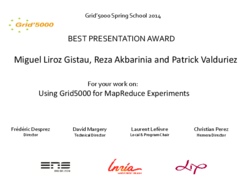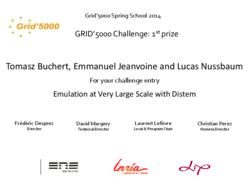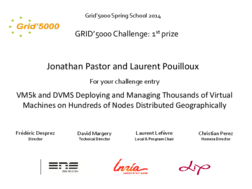Grid5000:Home
|
|
Latest updates from Grid'5000 users
- Publications
Five random publications that benefited from Grid'5000 (at least 2929 overall):
- Wèdan Emmanuel Gnibga. Modeling and optimization of Edge infrastructures and their electrical systems. Databases cs.DB. Université de Rennes, 2024. English. NNT : 2024URENS069. tel-04967447 view on HAL pdf
- Hugo Thomas, Guillaume Gravier, Pascale Sébillot. One-shot relation retrieval in news archives: adapting N-way K-shot relation classification for efficient knowledge extraction. KES 2024 - 28th International Conference on Knowledge-Based and Intelligent Information & Engineering Systems, Sep 2024, Seville, Spain. pp.1060-1069. hal-04708239 view on HAL pdf
- Youenn Merel Jourdan, Mathieu Acher, Camille Maumet. In the Search for Truth: Navigating Variability in Neuroimaging Software Pipelines. SPLC 2025 - 29th ACM International Systems and Software Product Line Conference, Association for Computing Machinery (ACM), Sep 2025, Coruna, Spain, Spain. pp.129-135, 10.1145/3744915.3748470. hal-05158426 view on HAL pdf
- Guillaume Schreiner, Pierre Neyron. SLICES-FR : l’infrastructure de recherche nationale pour l’expérimentation Cloud et Réseaux du futur. JRES 2024 - Journées réseaux de l'enseignement et de la recherche, Renater, Dec 2024, Rennes, France. pp.1-15. hal-04893845 view on HAL pdf
- Alexandre Bonvoisin, Clément Quinton, Romain Rouvoy. Understanding the Performance-Energy Tradeoffs of Object-Relational Mapping Frameworks. SANER'24 - 31th IEEE International Conference on Software Analysis, Evolution and Reengineering, Mar 2024, Rovaniemi, Finland. pp.11. hal-04401643v2 view on HAL pdf
Latest news
Grid'5000 tutorial days in Lille
We are happy to let you known that tutorials around Grid'5000 will be organized in Lille on November 20th, 2014, with a few seats available for people outside Lille. All information on the dedicated web page.
Grid'5000 spring school now finished
The Grid'5000 spring school took place between June 16th, 2014 and June 19th, 2014 in Lyon. Three awards were given for presentation or challenge entries (the challenge entries ended as a tie):
|
Best presentation award to Miguel Liroz Gistau, Reza Akbarinia and Patrick Valduriez |
Best challenge entry to Tomasz Buchert, Emmanuel Jeanvoine and Lucas Nussbaum |
Best challenge entry to Jonathan Pastor and Laurent Pouilloux |
Grid'5000 at a glance
- Grid'5000 is a scientific instrument for the study of large scale parallel and distributed systems. It aims at providing a highly reconfigurable, controlable and monitorable experimental platform to its users. The initial aim (circa 2003) was to reach 5000 processors in the platform. It has been reframed at 5000 cores, and was reached during winter 2008-2009.
- The infrastructure of Grid'5000 is geographically distributed on different sites hosting the instrument, initially 9 sites in France (10 since 2011). Porto Alegre, Brazil is now officially becoming the first site abroad.
Sites:
- Grid'5000 is a research effort developing a large scale nation wide infrastructure for large scale parallel and distributed computing research.
- 19 laboratories are involved in France with the objective of providing the community a testbed allowing experiments in all the software layers between the network protocols up to the applications.
The current plans are to extend from the 9 initial sites each with 100 to a thousand PCs, connected by the RENATER Education and Research Network to a bigger platform including a few sites outside France not necessarily connected through a dedicated network connection. Sites in Brazil and Luxembourg should join shortly, and Reims has now joined.
All sites in France are connected to RENATER with a 10Gb/s link, except Reims, for the time linked through a 1Gb/s
This high collaborative research effort is funded by INRIA, CNRS, the Universities of all sites and some regional councils.
ALADDIN-G5K : ensuring the development of Grid'5000
For the 2008-2012 period, Engineers ensuring the development and day to day support of the infrastructure are mostly provided by INRIA, under the ADT ALADDIN-G5K initiative.
HEMERA: Demonstrating ambitious up-scaling techniques on Grid'5000
Héméra is an INRIA Large Wingspan project, started in 2010, that aims at demonstrating ambitious up-scaling techniques for large scale distributed computing by carrying out several dimensioning experiments on the Grid’5000 infrastructure, at animating the scientific community around Grid’5000 and at enlarging the Grid’5000 community by helping newcomers to make use of Grid’5000.
Initial Rationale
The foundations of Grid'5000 have emerged from a thorough analysis and numerous discussions about methodologies used for scientific research in the Grid domain. A report presents the rationale for Grid'5000.
In addition to theory, simulators and emulators, there is a strong need for large scale testbeds where real life experimental conditions hold. The size of Grid'5000, in terms of number of sites and number of processors per site, was established according to the scale of the experiments and the number of researchers involved in the project.
Current funding
As from June 2008, INRIA is the main contributor to Grid'5000 funding.
INRIA |
CNRS |
UniversitiesUniversity Joseph Fourier, Grenoble |
Regional councilsAquitaine |







